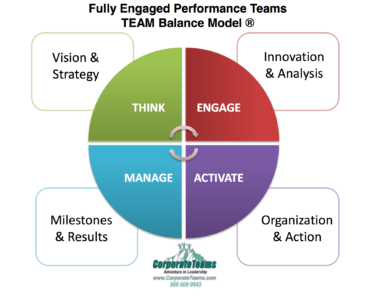Teamwork Requires Team Balance

Today’s highly competitive and dynamic workplace challenges the best of teams. What makes one team more effective than another? How does a team maintain balance?
U.S. culture promotes short term results which can derail balanced teamwork. The financial industry is a great example where the focus on short term profits at the expense of a long term strategy destroyed companies and careers. In fact many companies today are so laser focused on ‘this quarter’s results’ that opportunities in the periphery are often lost or completely ignored.
4 Essential Elements for Balanced Teamwork
T = THINK
This is the most difficult element of team balance across the U.S. In a culture that promotes action and results, slowing down to dive into long term strategy can feel like ‘inaction’ with teams wanting to quickly ‘check it off the list’. It is essential that the team address these critical questions to develop the highest quality strategies.
- What is our overall vision/objective?

- What information do we have available to us now?
- What additional information do we need to consider all aspects of the objective? Teams like to bypass this step and move forward quickly without all the information.
- What assumptions may limit our thinking? Often understanding overall objectives and possibilities are based on inaccurate assumptions. Information is incomplete and quickly reviewed. Team members want to move into motion. What did the team assume that may have moved them forward in the wrong direction by moving too quickly?
- What is our team potential or target? What are we aiming for across the board. Not just the big number – what else really matters to get us to our goal?
- Encourage your team to slow down and take some time to THINK.
E = ENGAGE
Now the team is ready to jump into brainstorming.This is where ideas are heard, possibilities are analyzed, and promotion of the ‘best alternative’ is pursued. It is critical that all team members are contributing to this process so that the team does not miss opportunities. Often we see that the quieter members of a team will have the best solution.
- What are possible alternatives to achieve our objective?
- Have we heard from ALL team members?
- Have we exhausted the possibilities? Don’t let the pressure of time cut brainstorming short.
- How should we evaluate each alternative?
- What is our back-up plan if the alternative we pursue fails?
A = ACTIVATE
If the ‘T’ and ‘E’ are effective, the ‘A’ should be fairly smooth. The best alternative has been selected and now the project plan is put into place. Note the word ‘If’. Many teams choose to jump right into ACTION without all the information, hit the wall, wonder what went wrong, and then loop back to THINK or ENGAGE. This trial and error process often leads to a solution, but often at the expense of maximizing results. We run out of time when we have to start the race over.
- What’s the best way to manage our resources?
- How will we manage the process?
- How will we support changes in the plan? Often a team running down the field is not going to want to slow down and consider a change of plan. But that might be exactly what is needed. Adaptability is important to balanced teamwork.
M = MANAGE
This is where results are measured, areas of process improvement are identified and quality enhancements are managed. Teams often run out of time and don’t allow for the MANAGE process. The end result is hurried at the expense of achieving the highest level of performance.
- What opportunities are there for process improvement?
- How will we measure and celebrate milestones? It’s important to have accomplishments along the way. It keeps the team motivated and tracks the small successes that lead to the overall objective.
- How will we manage our time so we stay on track to achieve our objective?
The TEAM Balance model is simple yet effective for all types of teams. Encourage your team to step back and consider the possibilities that each element of TEAM contributes to the success of the team. Different team members bring unique skills. The best teams understand how each team member thinks and how they interact in the workplace. Invest in your team with a communications assessment and leverage team members for success.
